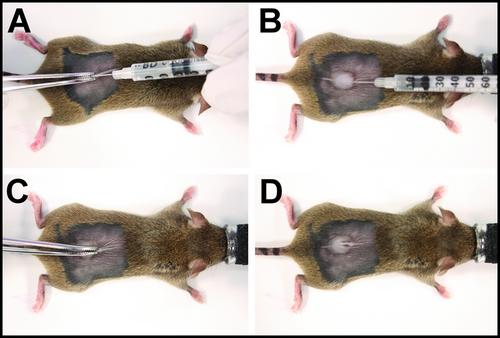{"title":"当前协议:用于药物疗效和机理研究的脱发症小鼠模型。","authors":"John P. Sundberg, Eddy H. C. Wang, Kevin J. McElwee","doi":"10.1002/cpz1.1113","DOIUrl":null,"url":null,"abstract":"<p>Alopecia areata is the second most common form of hair loss in humans after androgenetic alopecia. Although a variety of animal models for alopecia areata have been described, currently the C3H/HeJ mouse model is the most commonly used and accepted. Spontaneous hair loss occurs in 15%-25% of older mice in which the lesions wax and wane, similar to the human disease, with alopecia being more common and severe in female mice. Full-thickness skin grafts from mice with spontaneous alopecia areata to young, normal-haired, histocompatible mice provide a highly reproducible model with progressive lesions that makes it useful for drug efficacy and mechanism-based studies. As alopecia areata is a cell-mediated autoimmune disease, transfer of cultured lymph node cells from affected mice to unaffected, histocompatible recipients also promotes disease development and provides an alternative, nonsurgical protocol. Protocols are presented to produce these models such that they can be used to study alopecia areata and to develop novel drug therapies. © 2024 The Author(s). Current Protocols published by Wiley Periodicals LLC.</p><p><b>Basic Protocol 1</b>: Full-thickness skin grafts to reproducibly induce alopecia areata in C3H/HeJ mice</p><p><b>Basic Protocol 2</b>: Adoptive transfer of cultured lymphoid cells provides a nonsurgical method to induce alopecia areata in C3H/HeJ mice</p>","PeriodicalId":93970,"journal":{"name":"Current protocols","volume":"4 8","pages":""},"PeriodicalIF":0.0000,"publicationDate":"2024-08-06","publicationTypes":"Journal Article","fieldsOfStudy":null,"isOpenAccess":false,"openAccessPdf":"https://onlinelibrary.wiley.com/doi/epdf/10.1002/cpz1.1113","citationCount":"0","resultStr":"{\"title\":\"Current Protocols: Alopecia Areata Mouse Models for Drug Efficacy and Mechanism Studies\",\"authors\":\"John P. Sundberg, Eddy H. C. Wang, Kevin J. McElwee\",\"doi\":\"10.1002/cpz1.1113\",\"DOIUrl\":null,\"url\":null,\"abstract\":\"<p>Alopecia areata is the second most common form of hair loss in humans after androgenetic alopecia. Although a variety of animal models for alopecia areata have been described, currently the C3H/HeJ mouse model is the most commonly used and accepted. Spontaneous hair loss occurs in 15%-25% of older mice in which the lesions wax and wane, similar to the human disease, with alopecia being more common and severe in female mice. Full-thickness skin grafts from mice with spontaneous alopecia areata to young, normal-haired, histocompatible mice provide a highly reproducible model with progressive lesions that makes it useful for drug efficacy and mechanism-based studies. As alopecia areata is a cell-mediated autoimmune disease, transfer of cultured lymph node cells from affected mice to unaffected, histocompatible recipients also promotes disease development and provides an alternative, nonsurgical protocol. Protocols are presented to produce these models such that they can be used to study alopecia areata and to develop novel drug therapies. © 2024 The Author(s). Current Protocols published by Wiley Periodicals LLC.</p><p><b>Basic Protocol 1</b>: Full-thickness skin grafts to reproducibly induce alopecia areata in C3H/HeJ mice</p><p><b>Basic Protocol 2</b>: Adoptive transfer of cultured lymphoid cells provides a nonsurgical method to induce alopecia areata in C3H/HeJ mice</p>\",\"PeriodicalId\":93970,\"journal\":{\"name\":\"Current protocols\",\"volume\":\"4 8\",\"pages\":\"\"},\"PeriodicalIF\":0.0000,\"publicationDate\":\"2024-08-06\",\"publicationTypes\":\"Journal Article\",\"fieldsOfStudy\":null,\"isOpenAccess\":false,\"openAccessPdf\":\"https://onlinelibrary.wiley.com/doi/epdf/10.1002/cpz1.1113\",\"citationCount\":\"0\",\"resultStr\":null,\"platform\":\"Semanticscholar\",\"paperid\":null,\"PeriodicalName\":\"Current protocols\",\"FirstCategoryId\":\"1085\",\"ListUrlMain\":\"https://onlinelibrary.wiley.com/doi/10.1002/cpz1.1113\",\"RegionNum\":0,\"RegionCategory\":null,\"ArticlePicture\":[],\"TitleCN\":null,\"AbstractTextCN\":null,\"PMCID\":null,\"EPubDate\":\"\",\"PubModel\":\"\",\"JCR\":\"\",\"JCRName\":\"\",\"Score\":null,\"Total\":0}","platform":"Semanticscholar","paperid":null,"PeriodicalName":"Current protocols","FirstCategoryId":"1085","ListUrlMain":"https://onlinelibrary.wiley.com/doi/10.1002/cpz1.1113","RegionNum":0,"RegionCategory":null,"ArticlePicture":[],"TitleCN":null,"AbstractTextCN":null,"PMCID":null,"EPubDate":"","PubModel":"","JCR":"","JCRName":"","Score":null,"Total":0}
引用次数: 0


